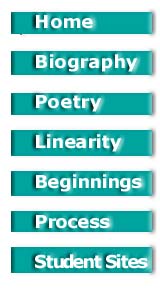I find the hypertext composing processes that my students
use very interesting. One student, for example, who did her biography
web on Thomas Edison wrote the entire site out using
a word processor, as if she were writing a report with small
headings. She was more familiar, of course, with word processing
and had experienced composing with that technology. The headings
in her word processed document were the titles of each lexia
she was planning to use in her site. When she finished word processing
her document(s), she then printed the pages and looked for words
and phrases that she could use as links. She highlighted these
with a pink marker. After that she looked for lexias on her printed
sheet that related to these highlighted words. If she didn't
find something, she found additional information and added it
to her "report." Once she was satisfied that she had
all the information she needed, and that she had enough links
to make her web interesting, she began copying and pasting her
individual blocks of text into a web editor.
Once everything was pasted into the web editor, she added
color and graphics.
I find it interesting that this student needed to see her
project in a more "linear"
format first. When I asked her about it, she simply replied that
it was easier for her to "see" her web when it was
laid out "beginning to end." But I suspect that this
student, when placed in a situation that challenged her to re-think
textual organization, returned to more familiar structures in
order to invent. Once she was satisfied that her text said what
she wanted it to say, she moved it into the less familiar space
of hypertext.
Initially this student was very resistant to hypertext. She
wrote in her response journal that she didn't understand why
she had to "do" history in a language arts class. But
in a later conversation she admitted that it wasn't so much the
integration of history and language arts, but the fact that she
was disoriented by the seeming lack of structure in hypertext
webs. "It didn't make any sense to me," she said in
a post project interview.
Such disequilibrium is common among hypertext readers, but
few studies have looked at this phenomenon during hypertext composing.
But that disequilibrium may explain why a number of students
find it helpful to write their lexias out by hand. Some do this
because they do not have a computer at home and they want to
work on their webs outside of class. Others simply believe they
can compose better "by hand." Teachers in the district
often ask students to write several drafts of their compositions
by hand before taking them to a computer lab to type their final
copies. This sends a message to students that the computer can
be used more as a glorified typewriter than as a tool that enables
drafting processes. And this could explain why some students
prefer to write their lexias out by hand first.
But many students, even after completing the poetry
web and moving on to the biography web,
seem to feel the need for linearity during their own composing
processes. They "mix things up" later. One student
reflected in his response journal: "I plan to have a linear
pattern and get my pages all sorted out, and then make [them]
multi-linear and break off to other things." The following
week he explained that he had done this and was happy with the
results. "I would do the same thing--have my biography be
linear and then make it multi-linear."
Certainly we are in a period of transition between electronic
text such as hypertext and book culture text. And such may be
the case for a long time. The fact that students rely on their
more traditional (for them) composing processes and more traditional
composing technology may be a reflection of that transition.
Or it may reflect a developmental process similar to that of
younger children who, though they can print quite well, rely
on drawings to convey meaning in their writing. Such drawings
seem to reflect their uncertainty about their own writing skills
(McLane, 1990). My students may be experiencing
the same kinds of uncertainties in the disjointed medium of hypertext.
My hope is that they will eventually feel comfortable enough
at a keyboard to write fluidly in that space, and as the year
progresses I find fewer and fewer students need to compose away
from the keyboard.
Whether they do their initial composing at the keyboard or
not, all of my students, once they learn the technology, seem
to enjoy working on their hypertext projects. I suspect some
of the enjoyment has to do with the playfulness
that hypertext, indeed all electronic text, enables.

